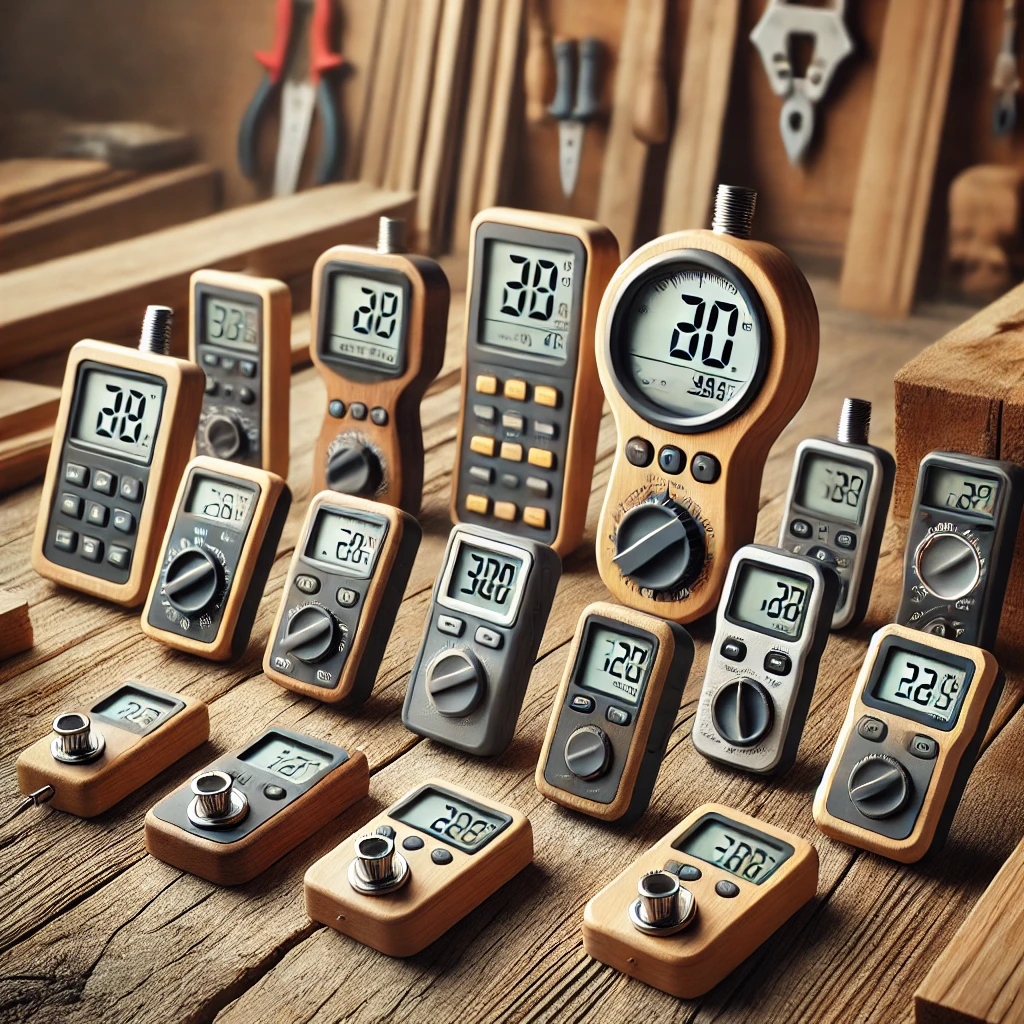Wood moisture meters are indispensable tools for anyone working with wood. Whether you’re a professional carpenter, a DIY enthusiast, or a furniture maker, these devices play a critical role in ensuring the success of your projects. By measuring the moisture content in wood, they help you avoid common issues like warping, cracking, and structural instability. In this blog post, we’ll explore the importance of wood moisture meters, how they work, and why they should be a part of your toolkit.
What Is a Wood Moisture Meter and How Does It Work?
A wood moisture meter is a handheld device designed to measure the amount of moisture present in wood. It works by using electrical resistance or electromagnetic waves to determine the water content within the material. There are two main types of wood moisture meters: pin-type and pinless.
Pin-type meters use two metal pins that penetrate the wood’s surface to measure moisture levels. On the other hand, pinless meters use sensors to scan the wood’s surface without causing damage. Both types are highly effective, but the choice depends on your specific needs and the type of wood you’re working with.
Why Wood Moisture Meters Are Crucial for Woodworking
1. Prevent Warping and Cracking
Wood is a hygroscopic material, meaning it absorbs and releases moisture based on its environment. If the moisture content is too high or too low, the wood can warp, crack, or shrink. A wood moisture meter helps you ensure that the wood is at an optimal moisture level before you start your project.
2. Ensure Longevity of Your Projects
Using wood with the wrong moisture content can lead to structural issues over time. For example, furniture made from overly moist wood may develop gaps or become unstable as it dries. By using a wood moisture meter, you can avoid these problems and create long-lasting pieces.
3. Save Time and Money
Imagine spending hours crafting a beautiful table, only to have it warp a few weeks later. A wood moisture meter helps you avoid such costly mistakes by ensuring the wood is ready for use. This saves you both time and money in the long run.
4. Improve the Quality of Your Work
Professional woodworkers know that precision is key to creating high-quality pieces. A wood moisture meter allows you to work with confidence, knowing that your materials are in the best possible condition.
5. Essential for Wood Flooring Installation
If you’re installing wood flooring, a wood moisture meter is a must. It ensures that the wood planks are acclimated to the environment, preventing issues like buckling or gaps after installation.
How to Use a Wood Moisture Meter Effectively
Using a wood moisture meter is simple, but there are a few tips to ensure accurate readings:
- Calibrate the Device: Before use, make sure your meter is calibrated according to the manufacturer’s instructions.
- Check Multiple Spots: Measure the moisture content at different points on the wood to get an average reading.
- Consider the Wood Species: Different types of wood have varying moisture levels, so be sure to account for this when taking measurements.
- Monitor Environmental Conditions: Humidity and temperature can affect moisture levels, so take these factors into consideration.
Types of Wood Moisture Meters
Pin-Type Wood Moisture Meters
Pin-type meters are ideal for measuring moisture in thicker pieces of wood. They provide precise readings but leave small holes in the material.
Pinless Wood Moisture Meters
Pinless meters are perfect for finished surfaces or delicate wood, as they don’t damage the material. They’re also faster to use, making them a popular choice for many woodworkers.
All-in-One Meters
Some advanced models combine both pin-type and pinless features, offering versatility for different projects.

Common Mistakes to Avoid When Using a Wood Moisture Meter
- Not Checking Calibration: Using an uncalibrated meter can lead to inaccurate readings.
- Ignoring Wood Species Settings: Different woods have different moisture levels, so always adjust your meter accordingly.
- Measuring Only One Spot: To get an accurate reading, measure multiple areas of the wood.
- Not Considering Environmental Factors: Humidity and temperature can affect moisture levels, so always take these into account.
Applications of Wood Moisture Meters
Wood moisture meters are used in a variety of applications, including:
- Furniture Making: Ensure the wood is at the right moisture level before crafting.
- Flooring Installation: Prevent issues like buckling or gaps in wood floors.
- Construction: Verify that framing lumber is dry enough for use.
- Firewood Preparation: Check if firewood is properly seasoned for burning.
How to Choose the Right Wood Moisture Meter
When selecting a wood moisture meter, consider the following factors:
- Type of Meter: Decide between pin-type, pinless, or all-in-one models based on your needs.
- Accuracy: Look for a meter with a high level of accuracy.
- Ease of Use: Choose a device with a user-friendly interface.
- Durability: Opt for a sturdy meter that can withstand regular use.
- Budget: Wood moisture meters come in a range of prices, so find one that fits your budget.
Benefits of Using a Wood Moisture Meter
- Improved Project Quality: Achieve better results by working with properly dried wood.
- Cost Savings: Avoid costly mistakes caused by warping or cracking.
- Time Efficiency: Complete projects faster by ensuring materials are ready for use.
- Professional Results: Create pieces that meet professional standards.
Frequently Asked Questions About Wood Moisture Meters
1. What is the ideal moisture content for wood?
The ideal moisture content depends on the application. For indoor furniture, it’s typically between 6% and 8%. For outdoor projects, it can be slightly higher.
2. Can I use a wood moisture meter on other materials?
While designed for wood, some meters can also measure moisture in other materials like drywall or concrete.
3. How often should I calibrate my wood moisture meter?
Calibration frequency depends on usage, but it’s a good idea to check it before each major project.
4. Are pinless meters as accurate as pin-type meters?
Yes, pinless meters are highly accurate and are often preferred for finished surfaces.
Tips for Maintaining Your Wood Moisture Meter
To ensure your wood moisture meter lasts for years, follow these maintenance tips:
- Store Properly: Keep the device in a dry, cool place to prevent damage.
- Clean Regularly: Wipe the pins or sensors after each use to maintain accuracy.
- Replace Batteries: Check the battery life regularly and replace them as needed.
- Avoid Extreme Conditions: Don’t expose the meter to extreme temperatures or humidity.
The Future of Wood Moisture Meters
As technology advances, wood moisture meters are becoming more sophisticated. Some newer models feature Bluetooth connectivity, allowing you to sync data with your smartphone or computer. Others come with built-in species settings for more accurate readings. These innovations make it easier than ever to achieve professional results in your woodworking projects.
Why Every Woodworker Needs a Wood Moisture Meter
In conclusion, wood moisture meters are essential tools for anyone working with wood. They help you avoid common issues like warping and cracking, save time and money, and ensure the longevity of your projects. Whether you’re a professional woodworker or a DIY enthusiast, investing in a high-quality wood moisture meter is a decision you won’t regret.
By understanding how to use these devices effectively and choosing the right one for your needs, you can take your woodworking projects to the next level. So, don’t wait—add a wood moisture meter to your toolkit today and experience the difference it makes!
